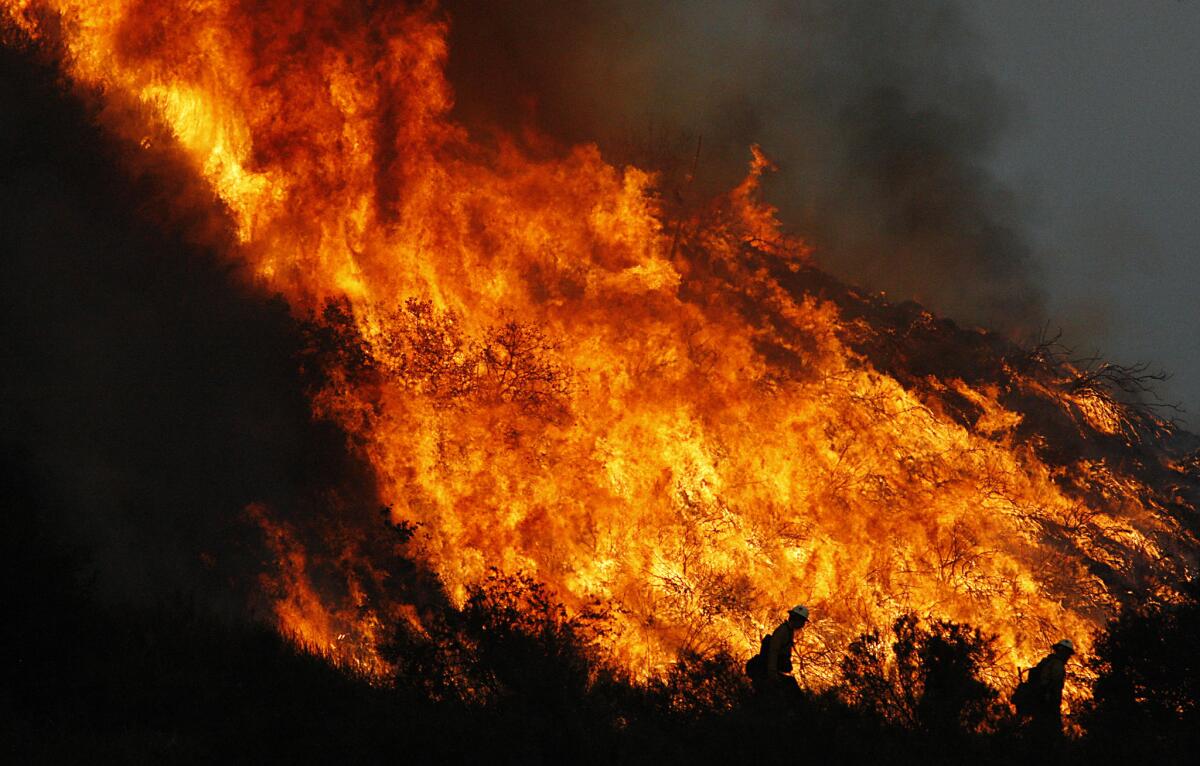Fire records raise questions on aircraft delay

Newly released records contradict a finding by the U.S. Forest Service that steep terrain prevented the agency from using aircraft to attack -- and potentially contain -- the Station fire just before it began raging out of control.
Experts on Forest Service tactics also dispute the agency’s conclusion that helicopters and tanker planes would have been ineffective because the canyon in the Angeles National Forest was too treacherous for ground crews to take advantage of aerial water dumps.
Two officers who helped direct the fight on the ground and from the sky made separate requests for choppers and tankers during a critical period on the deadly fire’s second day, according to records and interviews.
At 12:49 a.m. on Aug. 27, Forest Service dispatch logs show, a division chief made this call for aircraft:
“Fire has spotted below the road, about five acres. Order one helitanker, three airtankers, any type. . . . Have them over the fire by 0700 hours.”
But the airtankers were canceled and the helitanker was significantly delayed, according to dispatch logs, deployment reports and interviews. The Times obtained the logs, reports and volumes of other documents through the federal Freedom of Information Act.
Records of the Day 2 battle do not cite the sheerness of the canyon above La Canada Flintridge as a reason for withholding the aircraft, which firefighters who were at the scene say might have stopped the blaze from erupting into the disaster that it became. The fire was the largest in Los Angeles County history, killing two firefighters, destroying about 90 dwellings and charring 250 square miles in one of America’s most-visited national forests.
Last month, a Forest Service review endorsed the decision to not send the helicopter and planes but failed to mention the officers’ independent calls, made more than six hours apart, for a heavy air assault.
“It just irks me to see . . . that they’re blaming the terrain for why no action was taken,” said Don Feser, a former fire chief for the forest who retired in 2007. “They’re just making excuses.”
“I’ve covered a lot of that ground, and there is only a small percentage of land that is too steep to put firefighters on,” said Feser, who worked in the Angeles National Forest for 26 years, the last seven as fire chief. “And if we can’t put firefighters on it, guess what we do? We use aircraft.”
An officer who took part in the Day 2 operation said the absence of ground crews in the canyon did not keep commanders from using aircraft to bombard the area later in the fight. “We ran helicopters down there all day,” he said.
Choppers and tankers just after sunup, he said, could have slowed the flames’ march through the canyon, doused the surrounding ridges and given ground crews a much better chance of knocking the blaze down along Angeles Crest Highway, a crucial defense line.
“You could have made a stand,” said the officer, who requested anonymity because he is not authorized to speak publicly about the matter.
The Forest Service says aerial drops at first light or soon after on Day 2 would have accomplished nothing. The agency also dismisses suggestions by some critics that its strategy was influenced by a memo issued three weeks before the fire that instructed forest supervisors to rein in costs.
In a statement, the Forest Service pointed to three dispatch entries that note the rugged terrain. But the entries don’t mention aircraft, and two of them were made minutes before a Forest Service division chief on the ground ordered the helicopter and tankers.
Tom Harbour, the agency’s director of Fire and Aviation Management, said in the statement that the tankers were “ordered prudently as a contingency, based on where the entire fire was and might be.” He said the tankers “could never have gotten close enough to the spot fire under the Angeles Crest Highway which ultimately caused the problems.”
But Feser and an officer who engaged the blaze that morning said planes could have dumped on the flames in the upper portion of the canyon as the fire climbed toward the ridge above the road.
Harbour and other officials did not respond to questions about who canceled the order for tankers and when, and they were not available for interviews after the statement was issued late Friday.
The Station fire broke out in midafternoon on Aug. 26 near the Angeles Crest Ranger Station, for which it was named. Hours of water dumps by Los Angeles County Fire Department helicopters helped the Forest Service limit the flames that day to 15 acres, according to records and interviews.
After the county aircraft were sent home, the fire began to grow overnight as embers caught low downward winds and drifted across Angeles Crest Highway, igniting straw-dry brush in the dark canyon below.
Deployment records referring to the orders for the air tankers and helitanker show the 7 a.m. arrival times highlighted as “special needs” -- but note that the planes were canceled at an unspecified point. The dispatch logs include no directive to cancel or delay the aircraft. Rather, they narrate an effort to secure other choppers from the Los Angeles County and city fire departments.
The Times asked for audio copies of more detailed radio transmissions, but the Forest Service has not provided them. The dispatch logs are meant to contain the most significant transmissions, agency officials say.
Commanders may also issue orders by cellphone or radio communications not captured in the logs, the officials say, although key decisions and tactical obstacles typically are reflected in daily summaries of a firefight. None of the summaries reviewed by The Times say that aerial dumps were ruled out because of the terrain.
At 7 a.m., despite the overnight order for large water-dropping aircraft, only a spotter plane from the state Department of Forestry and Fire Protection was over the flames, say people familiar with the operation. The spotter crew was tasked with directing the air attack, and its captain immediately radioed for choppers and tankers but was told they would not be available in force for two hours or more, according to these sources, who asked to remain unidentified because they do not have permission to discuss the operation.
The first helitanker reached the blaze about 8 a.m., the sources say. By then, the flames had jumped the highway and were racing into the forest, outrunning ground crews. Deployment records show that the Forest Service then began ordering more aircraft.
In September, Angeles Fire Chief David Conklin and the county fire department’s No. 2 executive, Chief Deputy John Tripp, told The Times that they believed the Forest Service had deployed enough aircraft to combat the blaze on Day 2. Conklin also said that, as the flames spread up and down the steep canyon, “You just couldn’t put people down-slope to fight that fire.”
But Conklin and Tripp did not say that the terrain had dissuaded commanders from ordering water dumps. And neither said that the sharpness of the canyon was a factor in the decision not to bring in more aircraft earlier in the morning, if only to begin unloading on the fire as soon as it scaled the highway.
“Was there a need for more helicopters? I don’t know,” Conklin said in September. “I wish we would have had more there that morning.”
The Forest Service review followed a Times report that the agency had misjudged the threat posed by the fire and scaled back its Day 2 response. The review was based on interviews with several Forest Service officers. Tripp sat on the panel that oversaw the inquiry, but also played a lead role in a subsequent county review that questioned the Forest Service’s aggressiveness. The county review urged the Forest Service to allow night missions by aircraft, which the federal agency has generally prohibited because of safety concerns. County choppers routinely fight fires after dark.
The county review said that daytime water dumps should begin at first light, and that its own commanders “should have been more assertive” and sent copters to the Station fire earlier on Day 2.
Feser, the former Angeles chief, said the fire might have been tamed even without night missions if the Forest Service had used time-honored tactics, starting with a fierce air assault on the difficult terrain.
“You win some and you lose some,” he said, “but at least you can say at the end of the day: ‘We gave it our best shot.’ ”
--
More to Read
Sign up for Essential California
The most important California stories and recommendations in your inbox every morning.
You may occasionally receive promotional content from the Los Angeles Times.











